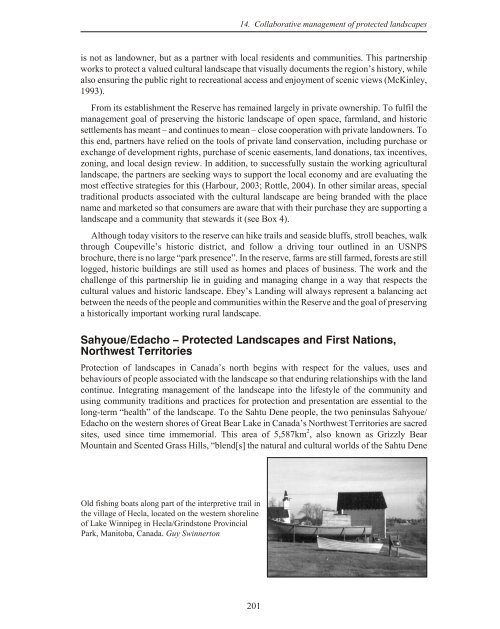The Protected Landscape Approach - Centre for Mediterranean ...
The Protected Landscape Approach - Centre for Mediterranean ...
The Protected Landscape Approach - Centre for Mediterranean ...
Create successful ePaper yourself
Turn your PDF publications into a flip-book with our unique Google optimized e-Paper software.
14. Collaborative management of protected landscapes<br />
is not as landowner, but as a partner with local residents and communities. This partnership<br />
works to protect a valued cultural landscape that visually documents the region’s history, while<br />
also ensuring the public right to recreational access and enjoyment of scenic views (McKinley,<br />
1993).<br />
From its establishment the Reserve has remained largely in private ownership. To fulfil the<br />
management goal of preserving the historic landscape of open space, farmland, and historic<br />
settlements has meant – and continues to mean – close cooperation with private landowners. To<br />
this end, partners have relied on the tools of private land conservation, including purchase or<br />
exchange of development rights, purchase of scenic easements, land donations, tax incentives,<br />
zoning, and local design review. In addition, to successfully sustain the working agricultural<br />
landscape, the partners are seeking ways to support the local economy and are evaluating the<br />
most effective strategies <strong>for</strong> this (Harbour, 2003; Rottle, 2004). In other similar areas, special<br />
traditional products associated with the cultural landscape are being branded with the place<br />
name and marketed so that consumers are aware that with their purchase they are supporting a<br />
landscape and a community that stewards it (see Box 4).<br />
Although today visitors to the reserve can hike trails and seaside bluffs, stroll beaches, walk<br />
through Coupeville’s historic district, and follow a driving tour outlined in an USNPS<br />
brochure, there is no large “park presence”. In the reserve, farms are still farmed, <strong>for</strong>ests are still<br />
logged, historic buildings are still used as homes and places of business. <strong>The</strong> work and the<br />
challenge of this partnership lie in guiding and managing change in a way that respects the<br />
cultural values and historic landscape. Ebey’s Landing will always represent a balancing act<br />
between the needs of the people and communities within the Reserve and the goal of preserving<br />
a historically important working rural landscape.<br />
Sahyoue/Edacho – <strong>Protected</strong> <strong>Landscape</strong>s and First Nations,<br />
Northwest Territories<br />
Protection of landscapes in Canada’s north begins with respect <strong>for</strong> the values, uses and<br />
behaviours of people associated with the landscape so that enduring relationships with the land<br />
continue. Integrating management of the landscape into the lifestyle of the community and<br />
using community traditions and practices <strong>for</strong> protection and presentation are essential to the<br />
long-term “health” of the landscape. To the Sahtu Dene people, the two peninsulas Sahyoue/<br />
Edacho on the western shores of Great Bear Lake in Canada’s Northwest Territories are sacred<br />
sites, used since time immemorial. This area of 5,587km 2 , also known as Grizzly Bear<br />
Mountain and Scented Grass Hills, “blend[s] the natural and cultural worlds of the Sahtu Dene<br />
Old fishing boats along part of the interpretive trail in<br />
the village of Hecla, located on the western shoreline<br />
of Lake Winnipeg in Hecla/Grindstone Provincial<br />
Park, Manitoba, Canada. Guy Swinnerton<br />
201

















